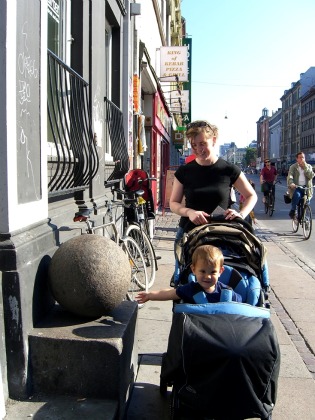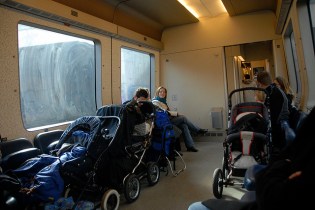Cross-posted from Sightline Daily.
I recall vividly how embarrassed I felt the first time I climbed on the bus with my baby boy. We’d waited expectantly — he bundled up in his stroller and me imagining the bus driver welcoming us aboard, lowering the wheelchair lift so we could roll on in style. In the stores and sidewalks of my neighborhood, people made way for us, slowing so we could pass on a congested sidewalk or holding doors open while we rolled into a shop.
But when the bus arrived, instead of lowering the lift, the driver told me to fold Orion’s stroller. My cheeks burned red as I hastily unpacked — diaper bag, toys, blanket, and groceries — while holding onto my squirming bundle of joy. Then, with one hand, I attempted to fold the stroller and carry the load aboard, knowing that everyone was watching me, passengers cursing under their breaths and the driver reviewing his timetable.
For most parents, an experience like that would have eliminated any thoughts of ever again taking their wheels on the bus. But I had no real choice. My husband and I had committed to staying in our apartment overlooking the main street running through Seattle’s University District. Some parents trade up to a minivan or SUV, but we had sold our two-door Civic. We gained a child and shed a car.
And, in most ways, I loved our car-free life. We explored our neighborhood together. People stopped to greet Orion on the sidewalk. I could point out interesting buildings or window displays. Outside our grocery store, the man selling the Real Change newspaper would always belt out, “Have a great day, little dude!” We soaked in the diversity of the city: new smells, sounds, and people.
But King County Metro was the sore spot of my car-free life. Agency rules required me to fold Orion’s stroller. Holding all of the stroller’s contents and Orion, I then had to find a seat before the bus lurched forward. Then I had to squish into a seat with all of our stuff and attempt to keep Orion from grabbing the stroller’s dirty wheels for the duration of the ride. Once we arrived at our stop, I had to reverse the whole ordeal.
My bus-riding fiascos led to an obsession with strollers: I was known to buy and sell them on Craigslist several times a month. My goal was to find that perfect stroller that I could really fold with one hand. I had a closet full of strollers, some undergoing testing and others, having failed, pending Craigslist pickup. It took seven strollers, but I found one that worked—the Britax Preview.
It wasn’t until my young family spent six months in Copenhagen, however, that I thought much about King County Metro’s stroller-folding rules. Copenhageners cart babies in enormous strollers, rolling cribs that dwarf our umbrella stroller and do not fold at all. And guess what? They are welcome aboard Copenhagen’s public transit, unfolded and unemptied. Caregivers with strollers use priority seating at the front of the bus. While buses only fit two strollers at once, busy routes’ service is so frequent that the wait is never long. Copenhagen’s trains also have open areas that hold caregivers with strollers, riders in wheelchairs, and bicyclists. Car-free parenting in Copenhagen was a breeze.
Back stateside, I decided to see how other transit systems compared. Portland’s TriMet buses are not much further along than Seattle’s. Open strollers can be brought on board but then must be immediately folded. The only advantage to this policy is that it’s hard to forget the diaper bag at the bus stop. Light rail in both Portland and Seattle allow open strollers aboard low-floor cars, however. And like Copenhagen, the Chicago Transit Authority (CTA) welcomes strollers aboard public transit. The CTA broadcasts its stroller-friendly policies with notice boards on buses and a YouTube video.
How can transit systems make life easier for moms, dads, and others who care for young children? An open-stroller policy is a crucial first step. After that, opportunities abound. Once strollers are legalized aboard transit, agencies can announce the improvement, like the CTA has done, with notices and videos. As buses and trains need replacement, agencies have the chance to purchase low-floor vehicles, and elevators and raised bus and train stops can make it easier for caregivers with strollers even for high-floor vehicles.
Another family-friendly tip from abroad: Copenhagen’s bus stops had electronic transit-trackers that were linked to GPS on buses. You didn’t have to own a smart phone to know when the next bus would arrive, and instead of peppering you with the frequent, “When is the bus coming?” your child can watch the bus stop tracker count down the minutes.
Allowing strollers on buses may seem trivial. But all families need affordable alternatives to driving, our economy needs weaning from fossil fuels, and our whole society needs to move beyond carbon, quick. With more strollers on the bus, fewer cars would clog the roads. Transit ridership would grow as caregivers transport tots to the doctor, play dates, and the grocery store. And perhaps most importantly, welcoming stroller wheels onto buses and trains has a long-lasting benefit: Kids will grow up seeing public transit as a normal part of the daily routine. The alternative is that we’ll raise another generation that sees driving as the norm.






